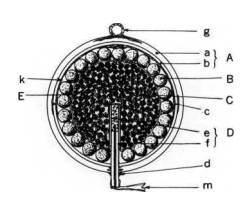Today i'm going to talk about the anatomy and function of a Fireworks Shell. As you may already now, there is a variety of fireworks like shells, rockets, mines, roman candles and many others, but today, let's see how a shell looks like and works.
The principle is very simple, take a look at the below image:

The shell consists of a hard casing, usually made of cardboard or plastic, in this case with a spherical shapping. Inside it, are the stars spread around the casing and in the middle, a bursting charge, made with a black powder like composition and a time fuse, which takes the fire from the outside into inside of the shell, making the burst charge to explode and disperse the starts all around in the air.
In the shell bottom, there is a lifting charge, made of granulated black powder that explodes and expels the shell into a high altitude.
All the package is put inside a mortar - a tube made with a hard material like steel, iron, cardboard or plastic (HDPE). The entire process is started by the ignition of the quick match fuse (quick to enable synchronization between multiple fireworks).
From the ground into the air step by step:
- The quick match is igneted by an external source of fire
- The fire quickly propagates to the lifting chage
- The lifting charge explodes and the gases made by the reaction expels the shell from the mortar
- The shell time fuse starts automatically burnig and the shell is arriving to it's apogee
- More or less 3 seconds from the lifting charge explosion, the time fuse is at the end of it's life and the burst charge explodes
- The stars or other effects of the shell catches fire are spread into the air.
Well, this is the basic function of a Fireworks Shell!
Hope you understand and wait for next posts, where i'll explain other kinds of fireworks.

Comments